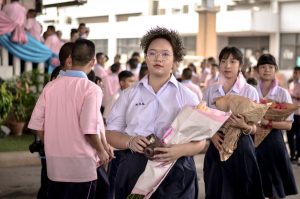Of all the groups that have been involved in Thailand’s simmering pro-democracy protests, among the most important, and least heralded, has been young women. Female university and school students in particular, have been conspicuously present in the front ranks of the youth-led demonstrations that rolled through the second half of 2020.
These contributions are detailed in a new report from the Observatory for the Protection of Human Rights Defenders (FIDH), which also examines the specific challenges that women protest leaders have faced from the Thai authorities. “Not only have these women, both youth and adults, made up a significant number of the participants, they have also played a key role in organizing and leading the demonstrations,” states the report, which is based on interviews with 22 women protest leaders.
Like their male counterparts, women protest leaders have been active in advancing the movement’s three core political demands: the resignation of Prime Minister Prayut Chan-o-cha, a genuinely democratic constitution, and – most explosively – reforms to shackle the power of the Thai monarchy. But as the FIDH report notes, protesters have also connected these discreet political demands to a broader critique of Thai patriarchal norms and the stifling gender roles into which young women are forced.
They have also addressed a number of issues that are specific to women, including abortion, taxes on menstrual products, and school rules that force girls to conform to an rigid and version of femininity. Feminist’s Liberation Front Thailand, a women’s rights group that regularly participated in the pro-democracy protests, has ignited a national discussion about the recognition of female bodily autonomy and women’s sexual and reproductive rights
“During the demonstrations,” the report argues, “women took to stages to criticize gender stereotypes, unequal power relations, and other injustices in Thai society that obstruct women and LGBTIQ people from enjoying their fundamental human rights.”
Among the many women protest leaders is Panusaya Sithijirawattanakul, a 22-year-old university student who gave a speech at a large rally in August calling openly for the reform of the Thai monarchy. “The monarchy and the military have all the power in Thailand,” Panusaya told the New York Times in September of last year. “I shouldn’t be afraid to say that men have almost all the power in Thailand.”
The military coup of 2014 not only abrogated Thai democracy; it also brought to power a deeply patriarchal institution, which quickly made its effects felt throughout Thai society. In a 2016 speech, Prime Minister Prayut, who led the coup and has remained in power ever since, expressed his view that men should hold power in public, while women should hold power in the home. “Everyone says that we have to create justice, women and men have equal rights,” he said. “Thai society will deteriorate if you think this way.” As the FIDH report shows, women’s participation in Thai political life plummeted following the military takeover.
Unsurprisingly, women protest leaders have been systematically targeted by both state and non-state actors for their activism. They have been among the several dozen activists who have been charged recently under Article 112 of the Thai penal code – the dreaded lese majeste law. They have also faced frequent human rights violations aimed at delegitimizing their work and credibility and discouraging them from participating in the demonstrations. These rights demonstrators were also targets of gender-specific attacks and harassment, including online.
Regrettably, in an echo of the New Left movement of the 1960s, female activists have also faced obstacles within pro-democracy ranks, “as they, their views, and their contributions were often ignored or excluded by certain parts of the movement itself.”
Last year, when Thailand’s protests were reaching their height, I spoke with the 28-year-old female activist Chonthicha Jangrew, who has also been in the forefront of the protests. Specifically I asked her about the disappearance of monuments to the 1932 revolution, which was followed by the drafting of Thailand’s first constitution and remains a touchstone for the pro-democracy movement.
“The government and ‘the man in the power’ are trying to erase values and history about the 1932 Siamese Revolution that changed Thailand from absolute monarchy to democracy,” she said, adding, “we need to fight for keeping it.”
The outlook for Thailand’s protests is currently uncertain, given the government’s assault on its leading members. But whenever it resurfaces, young women will be once again be at the forefront.

































